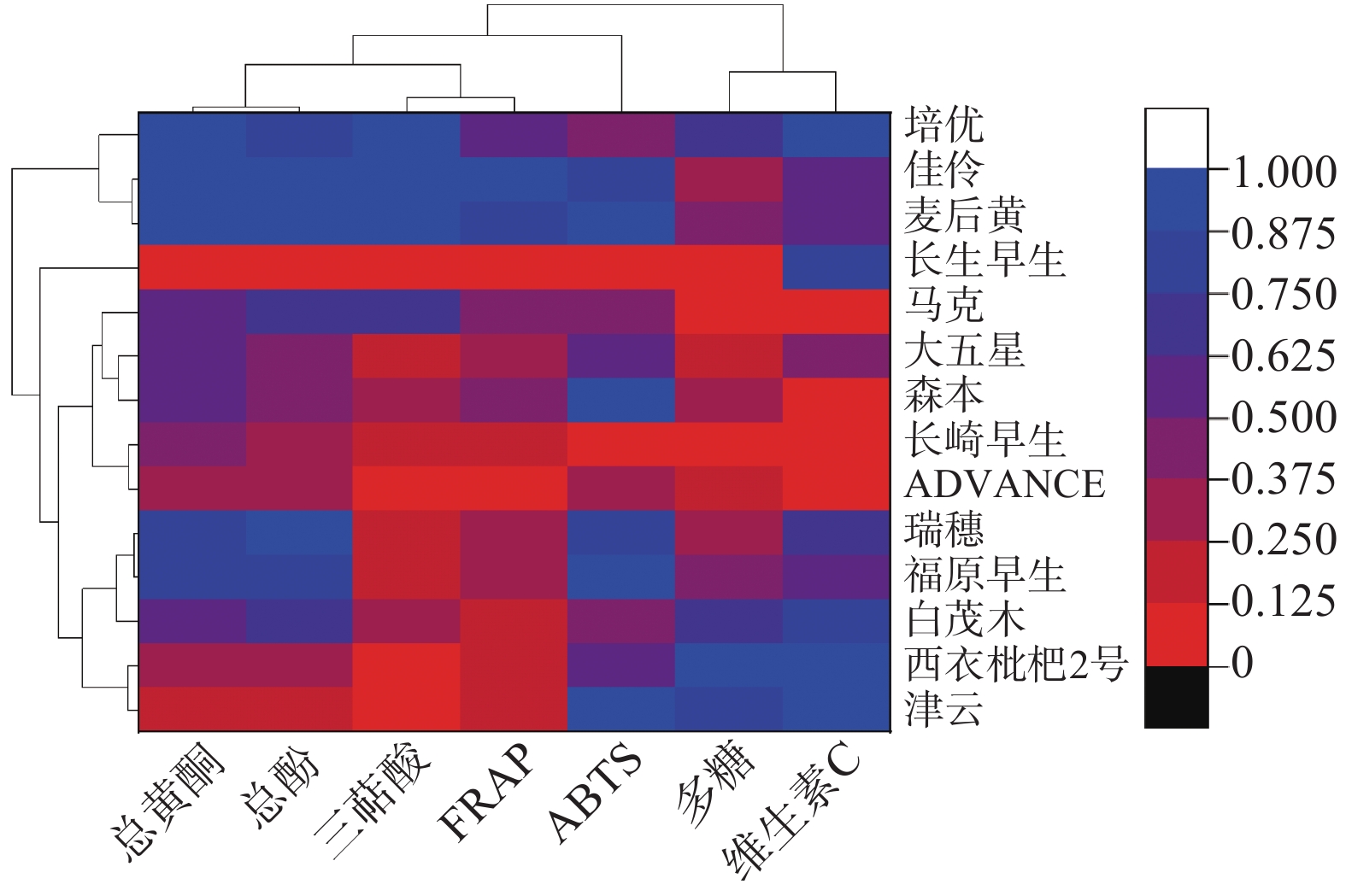| [1] |
|
| [2] |
Tian Xuyan, Tang Lipeng, Wei Fengjiao, et al. Pentacyclic triterpene compounds from loquat leaves reduce skin inflammation and epidermal hyperplasia in psoriasis via inhibiting the Th17 cells[J]. Molecular Immunology,2021,132:11.
|
| [3] |
胡蔚, 李岚. 枇杷叶提取物对卵清蛋白诱导的哮喘小鼠气道炎症和气道重塑的影响[J]. 中国现代应用药学,2021,38(1):20−27.
|
| [4] |
肖旭坤, 王翰华, 阮洪生. 枇杷叶化学成分和药理活性研究进展[J]. 中医药导报,2019,25(21):60−66.
|
| [5] |
卿樱露, 孔钰婷, 何丹, 等. 新食品原料——枇杷叶研发现状与展望[J]. 粮食科技与经济,2020,45(1):145−148.
|
| [6] |
|
| [7] |
Kou X H, Chen Q, Li X H, et al. Quantitative assessment of bioactive compounds and the antioxidant activity of 15 jujube cultivars[J]. Food Chemistry,2015,173:1037−1044. doi: 10.1016/j.foodchem.2014.10.110
|
| [8] |
Qiao A M, Wang Y H, Xiang L M, et al. Triterpenoids of sour jujube show pronounced inhibitory effect on human tumor cells and antioxidant activity[J]. Fitoterapia,2014,98:137−142. doi: 10.1016/j.fitote.2014.07.020
|
| [9] |
Xiao S L, Tian Z Y, Wang Y F, et al. Recent progress in the antiviral activity and mechanism study of pentacyclic triterpenoids and their derivatives[J]. Medicinal Research Reviews,2018,38(3):951−976. doi: 10.1002/med.21484
|
| [10] |
Wang Z H, Hsu C C, Huang C N, et al. Anti-glycative effects of oleanolic acid and ursolic acid in kidney of diabatic mice[J]. European Journal of Pharmacology,2010,628(1):255−260.
|
| [11] |
罗吉庆, 张永杰, 江丽慧, 吴艾频, 夏敏. 枇杷营养价值和功能价值的应用研究[J]. 农产品加工,2021(4):83−87.
|
| [12] |
Li Feng, Li Yijia, Li Qingxian, et al. Eriobotrya japonica leaf triterpenoid acids ameliorate metabolic syndrome in C57BL/6J mice fed with high-fat diet[J]. Biomedicine & Pharmacotherapy,2020,132:1.
|
| [13] |
Butros L J, Bussel J B. Intracranial hemorrhage in immune thrombocytopenic purpura: A retrospective analysis[J]. Journal of Pediatric Hematology/oncology,2003,25(8):660−664. doi: 10.1097/00043426-200308000-00017
|
| [14] |
Wu Dingtao, Fu Yuan, Guo Huan, et al. In vitro simulated digestion and fecal fermentation of polysaccharides from loquat leaves: Dynamic changes in physicochemical properties and impacts on human gut microbiota[J]. International Journal of Biological Macromolecules,2020(prepublish).
|
| [15] |
Shoko Taniguchi, Yoko Imayoshi, Eri Kobayashi, et al. Production of bioactive triterpenes by Eriobotrya japonica calli[J]. Phytochemistry,2002,59(3):315−323. doi: 10.1016/S0031-9422(01)00455-1
|
| [16] |
宋星, 王婷婷, 杨晓丹, 等. 枇杷叶中含科罗索酸提取物的分离纯化及降血糖活性研究[J]. 中国新药杂志,2017(2):214−219.
|
| [17] |
林国荣, 郭养浩. 枇杷叶中熊果酸和科罗索酸分离工艺优化[J]. 食品工业科技,2014,35(24):304−307, 341.
|
| [18] |
徐建国. 枇杷干叶的多糖和总黄酮提取及其抗氧化活性研究[J]. 林业建设,2015(5):42−53.
|
| [19] |
黄素华, 邱丰艳, 戴婉妹, 等. 枇杷叶多糖纯化工艺及抗氧化活性研究[J]. 食品工业科技,2017,38(5):205−209.
|
| [20] |
|
| [21] |
李婷. 枇杷叶的ISSR遗传差异分析及化学成分含量相关性研究[D]. 福建: 福建中医药大学, 2012.
|
| [22] |
|
| [23] |
|
| [24] |
王海佳. 紫外分光光度法研究维生素C的稳定性及蔬果和果汁中含量的测定[D]. 山西: 山西医科大学, 2015.
|
| [25] |
|
| [26] |
洪燕萍. 枇杷属植物叶片成分及抗氧化活性研究[D]. 广东: 华南农业大学, 2007.
|
| [27] |
刘玉明, 李珂娴, 何颖, 等. 枇杷花水提液总酚含量的Folin-Ciocalteu法测定[J]. 时珍国医国药,2017,28(4):838−840.
|
| [28] |
Coklar H, Akbulut M. Anthocyanins and phenolic compounds of Mahonia aquifolium berries and their contributions to antioxidant activity[J]. Journal of Functional Foods,2017,35:166−174. doi: 10.1016/j.jff.2017.05.037
|
| [29] |
汪世浩, 闫其朋, 周玉波. 枇杷叶及其炮制品中总三萜的含量分析[J]. 中国民族民间医药,2017,26(12):22−23, 27.
|
| [30] |
Ercisli S, Gozlekci S, Sengul M, et al. Some physicochemical characteristics, bioactive content and antioxidant capacity of loquat ( Eriobotrya japonica (Thunb.) Lindl.) fruits from Turkey[J]. Scientia Horticulturae (Amsterdam),2012,148:185−189. doi: 10.1016/j.scienta.2012.10.001
|
| [31] |
Garcia-Cruz L, Duenas M, Santos-Buelgas C, et al. Betalains and phenolic compounds profiling and antioxidant capacity of pitaya (Stenocereus spp.) fruit from two species (S. pruinosus and S. stellatus)[J]. Food Chemistry,2017,234(Nov. 1):111−118.
|
| [32] |
张文娜. 枇杷果实酚类物质组分分析及其生物活性评价[D]. 杭州: 浙江大学, 2015: 13−14.
|
| [33] |
廖圆圆, 王燕新, 郭晓农, 等. 枇杷叶总黄酮提取及体外抗氧化的研究[J]. 西北民族大学学报(自然科学版),2020,41(1):60−64.
|
| [34] |
付晓丹, 汤春丰, 刘壤莲, 等. 枇杷叶黄酮提取物的抗氧化作用研究[J]. 食品工业科技,2015,36(1):135−139.
|
| [35] |
戴云, 邱晓燕, 何耀莹, 等. 齐墩果酸和熊果酸对DPPH自由基的清除作用[J]. 云南民族大学学报(自然科学版),2012,21(6):395−398.
|
| [36] |
吴媛琳, 赵听, 张凯煜, 等. 枇杷不同部位主要有效成分含量及抗氧化活性比较[J]. 西北林学院学报,2015,30(1):196−201.
|
| [37] |
马哲龙, 吴增艳, 蒋福升, 等. 塘栖产枇杷叶的药材品质分析[J]. 中国医药导报,2018,15(30):111−114.
|
| [38] |
王建超. 枇杷叶多酚提取、纯化及其抗氧化、抑菌活性研究[D]. 福州: 福建农林大学, 2015.
|
| [39] |
|











 DownLoad:
DownLoad: